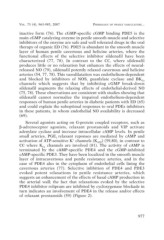Page 167 - 73_04
P. 167
VOL. 73 (4), 963-985, 2007 PHISIOLOGY OF PENILE VASCULATURE...
inactive form (76). The cGMP-specific cGMP binding PDE5 is the
main cGMP catalyzing enzyme in penile smooth muscle and selective
inhibitors of the enzyme are safe and well tolerated drugs in the oral
therapy of organic ED (76). PDE5 is abundant in the smooth muscle
layer of human penile cavernous and helicine arteries, where the
functional effects of the selective inhibitor sildenafil have been
characterized (77, 78). In contrast to the CC, where sildenafil
produces little or no relaxation but enhances the effects of neural-
released NO (79), sildenafil potently relaxed cavernous and helicine
arteries (54, 77, 78). This vasodilatation was endothelium-dependent
and blocked by inhibitors of NOS, guanlylate cyclase and BKCa
channels which suggests that by inhibiting cGMP break-down
sildenafil augments the relaxing effects of endothelial-derived NO
(75, 78). These observations are consistent with studies showing that
sildenafil cannot normalize the impaired endothelium-dependent
responses of human penile arteries in diabetic patients with ED (65)
and could explain the suboptimal responses to oral PDEs inhibitors
in these patients, in whom endothelial NO availability is decreased
(69).
Several agonists acting on G-protein coupled receptors, such as
ß-adrenoceptor agonists, relaxant prostanoids and VIP activate
adenylate cyclase and increase intracellular cAMP levels. In penile
small arteries, PGE1 relaxant reponses are mediated by cAMP and
activation of ATP-sensitive K+ channels (KATP) (59,80), in contrast to
CC where KCa channels are involved (81). The activity of cAMP is
terminated by the cAMP-specific PDE4 and the cGMP-inhibited
cAMP-specific PDE3. They have been localized in the smooth muscle
layer of intracavernous and penile resistance arteries, and in the
case of PDE4 also in the cytoplasm of endothelial cells lining the
cavernous arteries (77). Selective inhbition of PDE4 and PDE3
evoked potent relaxations in penile resistance arteries, which
suggests an enhancement of the effects of basal cAMP production in
the arterial wall; the fact that relaxations evoked by the selective
PDE4 inhibitor rolipram are inhibited by cycloxygenase blockade in
turn indicates an involvement of PDE4 in the release and/or effects
of relaxant prostanoids (59) (Figure 2).
977

